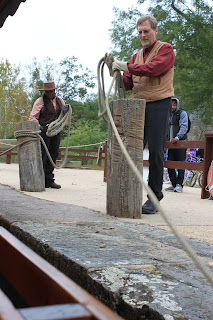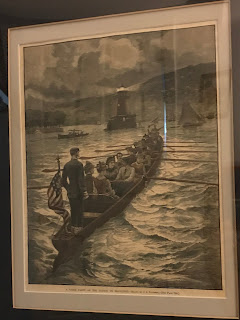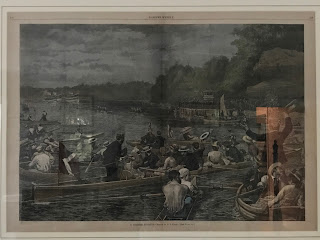Serendipity or six degrees of separation? I collect a variety of things...quilts, napkin rings, art, and rowing related items.
I was lucky enough to meet up with Eddie Ross and Jaitan Kochar at the Main Line Antiques show on Sunday.
And their charming pup.
Serendipity. While there I spotted two small framed rowing pictures in John Forster's
Barometer Fair booth that just spoke to me. The website doesn't say so but he also has some rowing things.
Here they are.
Are You Ready
The Final Sprint
These are especially interesting for me because I've been involved in rowing. They are Stevengraph pictures, woven silk in the original mat. An added plus ... in a former life I was a weaver. These are pictures that are woven on Jacquard looms. Thomas Stevens of Coventry England adapted the silk ribbon making process for pictures after the bottom fell out of the silk brocade and ribbon market in the 1860. Many weavers were thrown out of work. He adapted and saved his workforce.
Jacquard looms are basically an early form of a computer if you are old enough you remember the IBM punch cards like my husband used in grad school. Same idea with the loom control. Here the designers enlarge a picture and transfer to graph paper the spot for each color change in the loom harness threading. Holes are punched in cards that are sewn together in a loop and feed into the looms. Ten or twelve colors were used. A 13 inch book mark could use 5500 cards. Each pass of the shuttle brings up a different combination of threads controlled by the cards. Repeat the loop many times, cut each picture apart and finish the ends. Pictures were mounted in cardboard frames.

I only have two and four harness looms that can do some patterns, these looms are capable of much more intricate designs. Stevens was a good marketer and by the 1880's had over 900 designs ranging from bookmarks to royal portraits, cards, hymns, Victorian life and small sporting scenes. From 1880 to 1940 production continued. The Steven's Cox Street factory was bombed during the WWII but the company lives on with the production of some of the universally used woven labels found in many pieces of clothing today. Label looms today are run by computer programs.
My Stevengraphs are from the series of sports pictures.You can see the warp and weft weave if you look closely .

The colors are still quite bright, dark blue oars for Oxford, light blue for Cambridge, pink faces.
Notice the boats are going in different directions in the two images.
The back of one includes a clipping about the other images available.
The Boat Race started in 1829 when Cambridge student Charles Merival challenged his Oxford friend Charles Wordsworth to a Boat Race at Henley-on-Thames in Oxfordshire. A crowd of 20,000 watched Oxford win the right to challenge the loser the next year. The town knew a success when they saw it and organized races that became the
Henley Royal Regatta. First held at Westminster in London, the Boat Race grew too crowded and in 1845 moved to Putney. After 1856 it became an annual event that now draws entries of club, college and secondary school teams from around the world.
I've hung my Stevengraphs at eye level next to my closet door where I can enjoy them everyday.
The Stevengraphs pushed all my buttons...weaving, rowing, art and a good find.
I have other rowing images in the house.
A Barge Party on the Hudson
I really love this one with the woman cox in her dress and straw hat. (Hard to get pictures without reflections.)
On The Sckuylkill River
Several French images I got in Paris.
Regates Internationales sur la Seine
Rowing Club, sur a le Lac Bois De Boulogne
Regattes de la Reole
Regattes sur la Tamise
Les Regattes Internatioles a Asnieres-Un Amatuer
Two A B Frost prints
A College Regatta
This one in a great tramp art frame. Found it in a barn in New Hampshire.
Watkins Regatta
1877 Columbia-Havard
Columbia -Harvard practice on the Connecticut River
Some posters.
This was a poster for a fund raiser for the TC Williams Crew program.
This poster was for an exhibit of rowing art at the USRowing convention I helped organize at Georgetown University.
Saturday Evening Post covers.
June 25,1935
August 15,1936
John Gable print
Vision
That one makes me see my daughter on the dock.
My favorite personal photos.
Lightweight Stroke
Varsity 8 Cox
Just to round things out some trophies. This one found in Vancouver shop, under a table, totally black with tarnish. Great engraving. Probably 1915ish by the costume of the rower.
A second rowing trophy, not engraved.
Finally some other sport trophies.
Fives Competition, Singles winner 1888.
Horse race Mexico City 1914
Not engraved, hall marked.
Serendipity all around.













































































